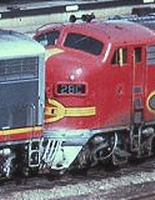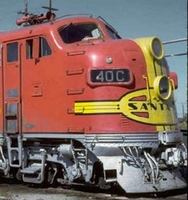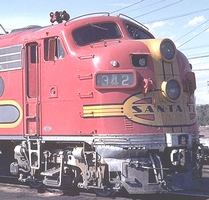When
Santa Fe purchased the F-3 and F-7 passenger diesels, they were
extremely
fussy about their appearance. This was because President
Gurley
insisted on it.
All
of the F-3's were upgraded with F-7 style grilles in 1950 and 1951.
This
was done on the locomotives assigned to Barstow and the
installation
was done at San Bernardino when units came in for their
annual
inspection. [Ed. note- Some grilles for this program were
removed
from freight units 260LABC-268LABC, delivered in August, 1951,
and
never replaced. It is believed that 240LABC may have had its grilles
removed
temporarily during 1950 as this program began.]
All
passenger and freight F units were to be made up in a 4 unit
combination
with the first 2 units facing forward and the rear two
facing
back. Note that Booster units had the indian logo on the
side
facing the front of the locomotive. This was done so that, in the
event
the
lead unit was damaged, the B unit could continue on to a point
where
the units could be turned. 325-class dual-service units in the A-B-B
configuration
were done the same way with the third unit facing back.
This
policy was ended in 1960.
All Santa Fe F units had their
"real" number in small numbers at the rear of
the sides. Even the
booster units had a small number at the rear on the
sides in black numbers in
the red stripe. In addition, the cab unit noses all
had a small L or a small
C at the bottom of the cigar band that indicated
what unit they really were.
Without refering to those details, initially the L
and C cab units were virtually
indistinguishable.
Several
changes were made between 1958 and 1960. Up to 1958, all
F units carried one number
in four unit combinations. For example,
16LABC was always kept together.
Because the Super Chief and El
Capitan
were consolidated at that time, a five unit locomotive was
necessary.
This caused some breaking of the numbered units to allow
more
freedom of mixing units. It was at that time that the "C" was placed
in the number boxes of all
C units [So if you see a photo that shows a "C"
in the numberboard, you will
know that it must have been taken after
1958. -ed.].
| At
the same time, passenger units 16-41, 300-305
assigned to Barstow were fitted with 5 chime Leslie air horns. [These were Leslie S-5T-R horns -ed.] |
|
 |
 |
| Units
42-47, second 306 to 314, 336 to 344 were all delivered with Nathan 5 chime
air horns with single air holes on the engineers side.
[These were Nathan M5 horns -ed.] |
|

Also, stirrup steps & grabs were placed on the noses for washing windows. All 325 class A units had steps on the front pilots as they were used in freight service as well as passenger service. |
|
| [above 3 photos cropped from Joseph Testagrosse postings to APBR] | |
Some exceptions to the above can be found on isolated units:
Ron Chamberlain has spotted some photographic evidence of exceptions
with some receiving Nathan M5R24's during their careers.
Examples: 19C and 30C appearing in Marvel's Santa Fe-All the Way.
In late
1960, ATSF started placing MU controls on all A units assigned
to
Barstow except 339-340, 341, 343. Trim above the fuel tanks was
removed
also:

(cropped from ATSF
F7 B Unit by Gary Morris. Posted
05/18/1998. )
Santa Fe's Passenger F units
were the most loved units that Santa Fe
ever had. They were
taken care of better than any of the other
locomotives up to about 1961,
when changes in management caused
the Santa Fe to take a different
course. After Mr Gurley's retirement,
the
newer management was in the mood to cut back. By 1961, all F-3
and
F-7 100MPH units were being mixed numerically. The exchanging of
parts like grilles and pilots
happened after that. You can date it by
looking to see if the units
have MU nose connectors. Santa Fe started
placing these on the freight
units in 1959 at San Bernardino. The 200 and
281 class units had been
kept together up till then when the railroad
went into a drive to increase
freight train speeds; the 4-unit sets were
broken up to make 6 units
sets for overland fast freights. The nose MU's
were needed to accomodate
running this many units.
Generally units were much
better taken care of before the MU nose
setups were applied.
Shortly after the railroad started getting the 800
and 900 class units [1959-1960],
Santa Fe started to transfer the 200 class
to Argentine with heavy maintenance
at Cleburne. Up to this point,
all units maintained at Barstow
and San Bernardino were done in a first-
class manner and parts were
not exchanged to my knowledge.
San Bernardino had done a
lot of upgrading like adding grilles to units
16-32 in 1950-1951.
Also, F-3 units were updated to F-7 standards with
the exception of dynamic
brakes.
Cleburne
was installing MU controls on F units assigned there and by
1966
all 325 class units were moved to Argentine with heavy maintenance
at
Cleburne. Cleburne was responsible for mixing pilots in the final
days.
Cleburne was never as particular as San Bernardino---they did a
lot
of mixing and matching from
about the mid-60's to the end. You can tell
the difference as the number
boards on these units were more homemade
at Cleburne while San Bernardino
was much more professional. By the 1970's
most
of the F units had been assigned to Argentine.
Management
was no longer interested in high maintenance on these older
units
and Cleburne was told to keep them running. If they failed, they
were
traded in or later converted to CF-7's. Only maintenance records,
(if
kept) would indicate the miscellanous changes to these units in their final
days.
It was always felt that engines assigned to Cleburne were kind of
the
back water and the place
where engines go before retirement. ATSF did
not spend as much money on
units assigned there and this would account
for the mixing of parts.
Keep in mind that there probably was no record of
all these changes because
frankly nobody cared as long as the units ran.
[So
the best record is probably the remaining photographs. -ed.]
When
R. D. Shelton retired as Vice-President Operations, Larry Cena took
over.
As far as he was concerned, the F's were old and needed to be
replaced
and numbering them was not a high priority. In fact in 1969 it
was
proposed to renumber the entire fleet and was appoved. The F-7
renumberings
were done very sloppily and without regard to much of a
future.
Mr.Cena did, however, propose the CF-7 project which did give
life
to the A units. At this time, the ATSF was on a big cut back
venture
and the CF-7's saved them quite a bit of money.
[Did
the B units just get salvaged during the later 1970s to provide parts
for
CF7 maintenance? -ed.]